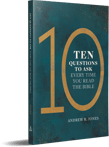When we quote Bible verses, our intentions are often good. We want to encourage ourselves and others, so we put Bible verses on home décor, shirts, mugs, bumper stickers, and social media. However, it can be easy to take Bible verses out of context if we don’t stop to ask, “How did we get here?”
Author Andrew R. Jones shares three popular Bible verses that are misunderstood and provides context for them below.
Jeremiah 29:11: God’s Plans for You
For I know the plans I have for you, declares the LORD, plans for welfare and not for evil, to give you a future and a hope.
When people quote Jeremiah 29:11, the tendency is to apply this verse individually. . . . The implication of this is that God knows what is happening in our lives and He will bring us through whatever difficulties we face. That is true. The difficulty with taking Jeremiah 29:11 out of context is often not a matter of truth or falsehood. We each have a hope and a future in Him because of Jesus, which will ultimately lead to eternal life with Him.
The problem is that in context, the promise of Jeremiah 29:11 is not for an individual. It is for a community. Furthermore, it is a promise that will not be fulfilled in the lifetime of anybody who hears the promise. So, how did we get here?
In Jeremiah 29, God is speaking to His people in exile. This is what the beginning of the chapter says:
These are the words of the letter that Jeremiah the prophet sent from Jerusalem to the surviving elders of the exiles, and to the priests, the prophets, and all the people, whom Nebuchadnezzar had taken into exile from Jerusalem to Babylon. (Jeremiah 29:1)
That verse sets our context. We are to take the perspective of exiles who are in Babylon, reading words addressed to them from Jerusalem. . . . Jeremiah tells the exiles to settle in. Their return from exile is not coming soon.
Jeremiah continues his Word from the Lord, saying,
When seventy years are completed for Babylon, I will visit you, and I will fulfill to you My promise and bring you back to this place. (Jeremiah 29:10)
Notice, this is the verse immediately preceding the oft quoted Jeremiah 29:11. The people hearing the promise about God’s plans, hope, and future for them have just been told this devastating news: they are going to die in exile. Their descendants will return to Jerusalem, but it is going to be seventy years. . . .
When God delivers the good news of hope and future, the people understand that promise is for them as a collective people. Their community will return to Jerusalem with God’s plan, hope, and future for them.
How does this verse sound different, knowing it is not a promise for individuals but for a community? . . .
Jeremiah 29:11 is more appropriately used for occasions when God’s people are suffering collectively as a community. Perhaps the most appropriate time to recall Jeremiah 29:1–11 is when a church is closing, when hope seems to be lost, or when God’s plan for the future is certainly good but is awfully hard to swallow. It is in those moments—when hope has faded for communities and churches—that the power of Jeremiah 29:11 comes to life. God has a longer view in mind than we do. God’s goodness stretches beyond our own lifetimes. Knowing the context of Jeremiah 29:11 does not diminish our own hope, but rather it centers our hope more firmly on who God is—a God who has plans beyond our earthly life span, a God who will bring us into the hope and future of eternal life. That is His plan, and it has been accomplished in Jesus.
Psalm 118:24: This is the Day
This is the day that the LORD has made; let us rejoice and be glad in it.
People commonly use this verse to refer to today. When we say “this is the day” in any other context, we tend to mean today, right now. The assumption then is that when the author (most likely David) wrote this psalm, he was referencing
the very day the psalm was being written.
We can in good conscience say that God has created all days, of course. . . . Again, the issue with taking this verse out of context is not one of truth or falsehood. God has indeed created all days, but is that what the author of Psalm 118 is referencing with the phrase “this is the day”? So, we ask the question “How did we get here?”
Psalm 118 begins with another well-known phrase, especially in Lutheran circles as it is part of a common table prayer before meals:
Oh give thanks to the LORD, for He is good; for His steadfast love endures forever! (Psalm 118:1)
The first few verses are about God’s steadfast love enduring forever. In verses 5–16, we see God referenced as one who answers and helps when we call to Him in distress. Though we are surrounded by enemies, God is our refuge. He is our
strength, song, and salvation.
In verse 17, we read, “I shall not die, but I shall live, and recount the deeds of the LORD.” In verses 22 and 23, we see verses that Jesus quotes: “The stone that the builders rejected has become the cornerstone. This is the LORD’s doing; it is marvelous in our eyes.” When Jesus speaks these words, it is during the early parts of Holy Week, a day or two after Palm Sunday, a few days before His death and resurrection.
In quoting Psalm 118:22, Jesus claims that verse is referencing Him, His death and resurrection. He is the stone that the builders (the religious leaders of the first century) rejected, crucified, and killed. But Jesus rose from the dead, becoming the cornerstone upon which the Church is built. The cornerstone is the first stone laid in ancient architecture. It is the stone upon which all other stones must align and conform to. We are built upon Jesus. We align and conform to Him. This is true now, but it is true in a more profound way in the
resurrection and eternal life. We conform to Jesus in that we will have
resurrected, glorified bodies just like He does.
When Psalm 118:23 says, “This is the LORD’s doing,” it is referencing the rejected stone becoming the cornerstone. “This” means Christ’s resurrection from the dead. In the next verse, the verse so often taken out of context, “this” is referencing the same thing. “This is the day” is not referencing every day. It is not referencing today. It is referencing the day above all days, Easter Sunday: the day of Christ’s resurrection. “This [Christ’s resurrection] is the LORD’s doing.” “This [Easter Sunday] is the day that the LORD has made.” In Christ’s resurrection, God creates a new day, a foretaste of all the days to come in eternal life.
So, if you have a coffee mug or tea towel with Psalm 118:24 on it, that is great. When you look at it from now on, remember, it is about more than today. It is about the most important day in the history of the world, Easter Sunday. Truthfully, that is what makes it so appropriate as a greeting for Sunday morning worship. This day, this gathering of God’s people to remember Easter, this little Easter is the day the Lord has made. Let us rejoice and be glad in the resurrection of Jesus.
Mark 12:41–44: On Giving
And He sat down opposite the treasury and watched the people putting money into the offering box. Many rich people put in large sums. And a poor widow put in two small copper coins, which make a penny. And He called His disciples to Him and said to them, “Truly, I say to you, this poor widow has put in more than all those who are contributing to the offering box. For they all contributed out of their abundance, but she out of her poverty has put in everything she had, all she had to live on.”
This is one of the stories [from the Gospel of Mark] frequently used to speak to the topics of giving or stewardship. As Jesus is finishing up His teaching in the temple courts, He sits down opposite the treasury. People are bringing in their offerings. . . . The widow is putting in more than one cent. . . . She is putting the last of her money into the temple treasury, money that could have bought her a meager meal.
Notice that Jesus’ commentary on this situation is not necessarily one of praise for the widow nor one of ridicule for those rich people putting in large sums of money. Jesus is simply stating a fact. This widow has put in all she has to live on, even though the amount is small. The others have put in large sums, but they will go home and have plenty of money remaining to them to live on.
Often when these verses are taken out of context, they add some sort of praise to Jesus’ tone regarding the widow, as if Jesus is holding up the widow as an example to His disciples and to us. So often, this story is taught in this way: be like the widow, give sacrificially. Jesus, however, does not say that. So, how did we get here?
Jesus enters Jerusalem on Palm Sunday in Mark 11:1–11. He cleanses the temple on Monday in Mark 11:15–19. Jesus has been teaching in the temple on the Tuesday of Holy Week from Mark 11:27 to this point in Mark 12:41–44. In that teaching time, various groups, including the Pharisees, Sadducees, Herodians, and scribes have all come to Jesus, asking Him questions. In the section immediately before we meet the widow, this is what Jesus says,
Beware of the scribes, who like to walk around in long robes and like greetings in the marketplaces and have the best seats in the synagogues and the places of honor at feasts, who devour widows’ houses and for a pretense make long prayers. They will receive the greater condemnation. (Mark 12:38–40)
Did you notice the connection? Jesus has just finished saying that people should beware of the scribes because they devour widows’ houses. A few minutes later, a widow comes, compelled to give all that she has to live on, a widow whose house has been devoured. Jesus’ commentary on the widow, in context, is a continuation of His condemnation on the scribes.
In the end, the widow’s role in this story is not an example that we are meant to emulate, but rather the widow stands as an example of who Jesus notices. Jesus notices the poor, the destitute, the overlooked, the abused. Jesus notices this widow and what has been done to her. She has been taken advantage of, not cared for by those around her who could provide for all of her needs. Her house has been devoured by the ambitious scribes.
In context, Jesus’ tone seems to be one of sadness, anger, and pity. He suffers with the widow. And soon, He will suffer for the widow.
Ten Questions to Ask Every Time You Read the Bible
 Whether you’re reading the Bible for the first time or you’ve read it cover to cover, these ten questions will help you discover truths from Scripture.
Whether you’re reading the Bible for the first time or you’ve read it cover to cover, these ten questions will help you discover truths from Scripture.
Blog post adapted from Ten Questions to Ask Every Time You Read the Bible, copyright © 2022 Andrew R. Jones. Published by Concordia Publishing House. All rights reserved.
Scripture: ESV®.














